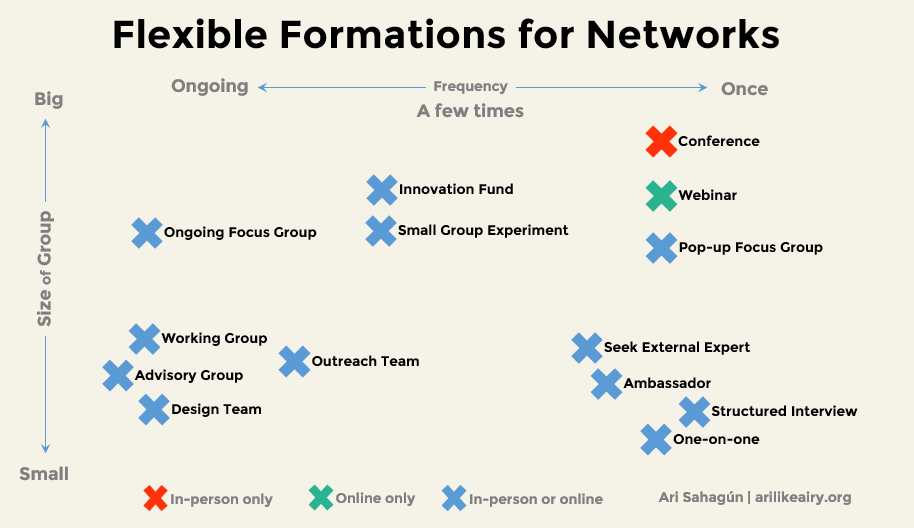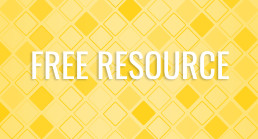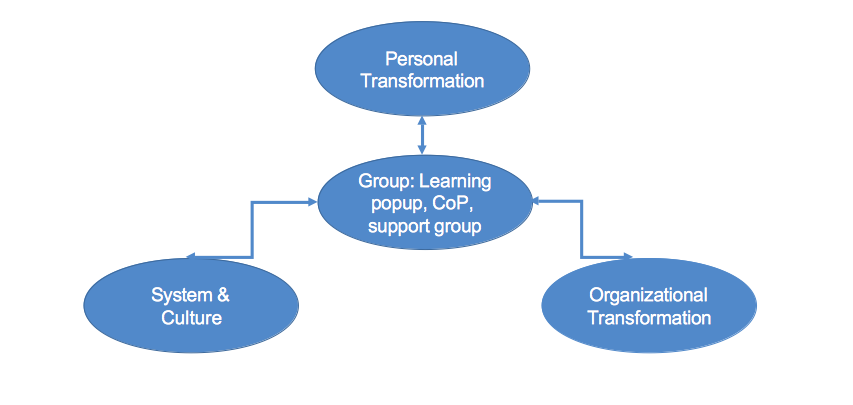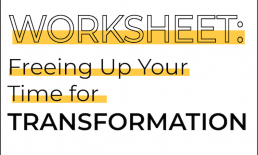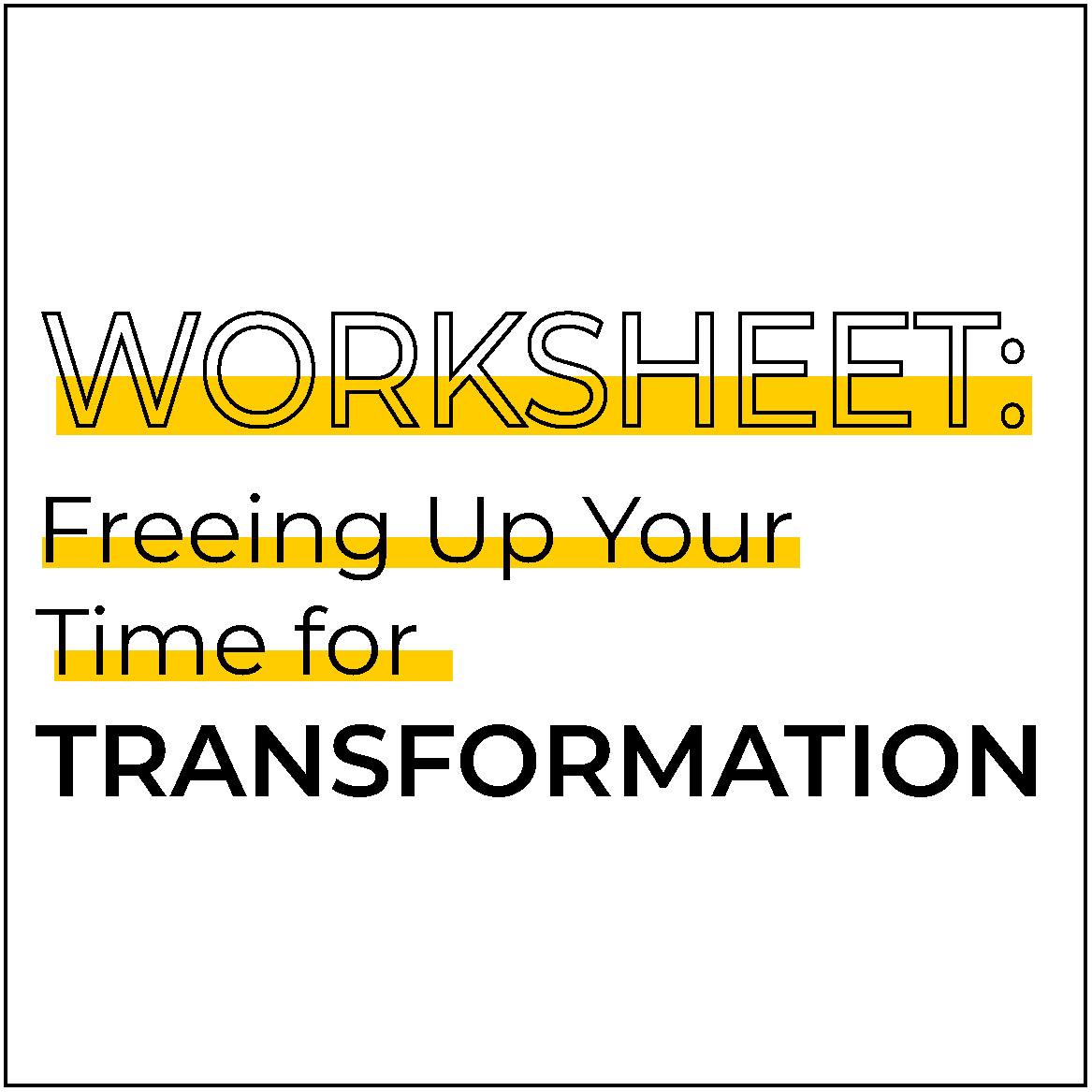Flexible Formations for Networks
[ap_spacing spacing_height="20px"]
Thinking about co-design embedded within a network presents additional challenges. Ideally, a design team creates many spaces to engage in co-design – both online and in-person – that allow for maximum input and creativity as well as respond to shifting levels of availability/capacity to participate.
What follows is a brainstorm I did with my sister, Licia, of the list of formations (groups within a network) that enable this. Furthermore, these formations can be organized from a central group - like a design team - or self-organized as they emerge from network members. [ap_spacing spacing_height="20px"]
[ap_spacing spacing_height="30px"]
| Formation | Definition |
| Advisory group |
Small group that lasts for the length of the project to advise and provide context for the design work; similar to design team but broader
|
| Ambassador |
One person does a one-on-one, then takes on work to do other one-on-ones, or takes information to broader group; “train-the-trainer” might fit here
|
| Conference |
Large group comes together with potential breakout groups, usually in-person
|
| Design team |
An ad hoc group that meets throughout the duration of the project (or sub-scope within it) to provide planning insight
|
| Innovation fund |
Selected group of projects that are funded for specific outcomes
|
| One-on-one |
A conversation between two people
|
| Ongoing focus group |
A representatively diverse group of people assembled to participate in a guided discussion about a particular product before it is launched, or to provide ongoing feedback on a political campaign, television series, etc.
|
| Outreach team |
Spreads the word about design process and reflections to rest of network
|
| Pop-up focus group |
A representative group of people that meets once to provide structured feedback on a specific topic
|
| Seek external expert |
Someone reaches out of core network for advice or thought leadership
|
| Small group experiment |
An ad hoc group that meets to engage with and provide feedback on a project, product, or part of it
|
| Structured interview |
A one-on-one with very specific outcomes
|
| Webinar |
An online lecture with potential Q+A
|
| Working group |
Small group of people who meet regularly with specific outcomes in mind; could be called a committee.
|
[ap_spacing spacing_height="20px"]
We encourage you to comment on this post so we can hear about your thoughts and experience.
[ap_spacing spacing_height="20px"]
Originally published at arilikeairy.org on March 26, 2018
[ap_spacing spacing_height="30px"]
Network Governance
[ap_spacing spacing_height="20px"]
Network governance is the idea that decision-making that is currently lodged in representative bodies such as congress or city councils can be shifted into self-organizing networks. This shift has the potential to massively increase participation and inclusion in policy making and, at the same time, ensure that policy making becomes more innovative, experimental, and capable of learning and transformation. Network governance has the potential to enable all of us to be part of co-creating a world that is good for all of us.[ap_spacing spacing_height="10px"]
Network governance can generate forms of governance that are equitable and inclusive, quick and creative in responding to issues and problems, and capable of tackling the complex and planet-threatening issues of our time.[ap_spacing spacing_height="10px"]
For example, food policy councils, at their best, are cross sector networks that include residents, government and educational representatives, non-profits and food related businesses. They research policy options for things such as rules regarding urban chickens, handling of food waste and support for community gardens, adapt these policies to their locale, and then present policy suggestions to city councils. It seems a small step to empower such councils to make the decisions themselves.[ap_spacing spacing_height="10px"]
Several new developments have made the shift to network governance possible.[ap_spacing spacing_height="25px"]
Self-organizing structures[ap_spacing spacing_height="15px"]
First, new self-organizing structures for network governance are being piloted. These include organizing decision-making into (usually small) work groups called circles: a small, diverse set of individuals who interact as peers and who care deeply about an issue take responsibility for a specific policy initiative - anyone can join the circle. The circle researches the issue and often engages many additional people in a co-design process to generate a draft policy proposal (through the use of technology which is discussed in the following section). Governance networks may have hundreds of circles operating at any one time, with many people involved in more than one circle. [ap_spacing spacing_height="25px"]
Innovative decision-making processes[ap_spacing spacing_height="15px"]
Then the circle uses an innovative decision-making process such as co-design, advice or consent. In the advice process, anyone who would be impacted by the decision has an opportunity (with a deadline) to give feedback on the proposal, which the circle tries to incorporate. The circle has final decision-making power, though if the proposal is controversial the time set to review the policy will be short. The idea is to try something out that is “good enough for now.” [ap_spacing spacing_height="20px"]
[ap_spacing spacing_height="20px"]In co-design or co-creation processes, diverse participants come together and design a new way of doing something, with decision-making woven into the design process, which then moves directly into a pilot phase. For example, a group of residents and organizations may join together to set up a new structure, such as an Innovation Fund that provides seed funds to community projects. This expands the definition of policy making to any collaborative act that contributes to community co-creation. Sometimes co-design is combined with advice or consent processes.[ap_spacing spacing_height="10px"]
Circles and advice/consent processes are currently being used in hundreds of innovative businesses and are now being piloted in a increasing number of networks.[ap_spacing spacing_height="25px"]
Helping participants shift to network values[ap_spacing spacing_height="15px"]
Network governance only becomes transformative when the underlying culture shifts. Network values/behaviors include interacting as peers, dismantling hierarchy and racism, embracing diversity and inclusion, letting go of control, becoming comfortable with uncertainty, seeing everything as an experiment, having space for reflection and learning. Network participants are much more likely to be able to make these shifts in the intimacy of circles, where they can track their progress on these through simple group surveys, then get support for change.[ap_spacing spacing_height="15px"]
The use of technology[ap_spacing spacing_height="10px"]
Next, the use of technology is making cross sector participation possible. Using zoom video conferencing sessions with breakout rooms for discussion combined with the use of google docs for gathering ideas, reflections and feedback makes involvement of many people possible. This can be combined with prioritizing and polling platforms such as sli.do and platforms such as loomio and participative budgeting platforms. In addition, innovators such as vTawain have used other platforms such as polis.[ap_spacing spacing_height="15px"]
Networks of networks[ap_spacing spacing_height="10px"]
The third development is the development of networks of networks for sharing, spreading and learning. These networks of networks are often focused on a specific issue area. For example, the hundreds of food policy councils in the U.S. have state networks, and the state networks are linked through a national network. Both state and national networks have frequent virtual (and occasional face-to-face) learning sessions where they share insights and strategies about specific policy areas and about other topics of relevance. Other networks of networks are perfecting communities of practice or learning clusters so networks are supported in their efforts to do system shifting work. [ap_spacing spacing_height="10px"]
Other networks of networks are convened around cross cutting issues or are bringing people from different (sometimes related) issue areas together for more systemic understanding. For example, Robert Wood Johnson Foundation has been convening networks working on different system elements it calls the Culture of Health (food access, housing, wellbeing, prison pipelines, etc). Other networks of networks are convening to learn more about networks and transformation or about racial justice and equity. These create pathways for viralness, large scale impact and transformation. For example, the use of zoom has spread through the nonprofit world at lightning speed, dramatically increasing the amount of collaboration happening.[ap_spacing spacing_height="15px"]
What would it look like?[ap_spacing spacing_height="10px"]
Imagine policy councils for every aspect of life: housing, health, recreation, education, etc. with most people involved in 2-3 circles at a time but providing advice on dozens or hundreds of proposals a year.
Most governance networks are likely to be local or regional. However, it would be exciting to explore how the networks of network might work nationally and internationally to solve huge, complex problems.[ap_spacing spacing_height="15px"]
How do we get there?[ap_spacing spacing_height="10px"]
Many networks already exhibit some but not all of the characteristics of network governance. By working as a catalyst network, we can help interested networks move to a more complete network governance form. We can create a network of networks interested in moving their networks to the next level and jointly develop a model of key elements of network governance, including case studies of network governance in practice.[ap_spacing spacing_height="10px"]
Also see https://docs.google.com/presentation/d/1I77C0T0UH5b0ZrMsb-QiIBjJkT1G1LlmotrQa1iK1jE/edit?usp=sharing
[ap_spacing spacing_height="25px"]
We encourage you to comment on this post so we can hear about your thoughts and experience. [ap_spacing spacing_height="40px"]
Network Weaver Free Resources Package
Each week, we add a new free item to our store.

This week we are offering: Network Weaver FREE RESOURCES PACKAGE.
ALL of the free resources currently available at the Network Weaver Resource Page in one complete downloadable file.
Systems Thinking and Networks
Last fall, I heard about an online educational portal called Plus Acumen, which advertises itself as the “world’s school for social change” and offers several free classes. Many of their offerings are geared towards providing practical and accessible tools that people involved in nonprofits, community groups, and networks can use to improve their efforts.
After looking through the course catalogue, I found and enrolled in a class called Systems Practice, led by Rob Ricigliano of The Omidyar Group. The class was insightful, and lead students through an intuitive series of exercises exploring systems through creating a framing question, identifying forces, creating a systems map using Kumu, and crafting a strategy rooted in leverage points.
Throughout the class, I gained a general framework to use to better understand how systems work, and tools that can improve the work I do.
I highly recommend this class to others interested in systems thinking and social change, as it is being offered again for free this fall starting October 9th.
Classes like this are important for advancing the practice of networks by integrating a holistic way of thinking about systems change with tools and strategies that networks can use to be more effective. As more networks blend systems thinking into their core strategies, the possibilities of accelerating transformational change expand, and areas for new tools, practices, and collaborations become clear.
If you’re interested in these items, I’d suggest taking the course, convening a team of people to enroll in the class with you, and share your learnings along the way, as well as ways you are integrating this into your network’s strategy.
[ap_spacing spacing_height="40px"]
Trust in Networks is Fundamental to Social Change
[ap_spacing spacing_height="25px"]
Trust is a core principle – in Chaos Theory, we’d call trust within human systems a powerful ‘Strange Attractor.’ [ap_spacing spacing_height="15px"]
The purpose of a Change Network is to amplify the flow of knowledge, information, resources, skills, and assets throughout all parts of the network – especially to where they can do the most good. To put everything we can contribute, collectively, into the shifts we’re trying to make – so that change is faster, more meaningful & relevant, and spreads further.
And as one who struggles greatly with trust – it’s glaringly obvious – without trust, nothing significant moves. It’s that simple, and abundantly clear.
But whenever the word comes up in community-work, I cringe a little. Especially in groups with different cultures and privilege gaps. Because what, really, are people espousing?
[ap_spacing spacing_height="25px"]
What do we mean when we say ‘trust’?
[ap_spacing spacing_height="15px"]
What IS it we’re trying to create together? And who gets to decide?
In her ‘Network Weaver’s Handbook‘ June Holley says:
"'We must trust each other for this to work' is a dangerous statement. Dangerous because it too often implies that trust is easily or instantly developed. Actually, we have little awareness of how authentic trust is built."
In fact, I’m a little afraid of saying what comes next – so this constitutes a small act of trust that I’ll be forgiven for writing what can’t help but come across as snarky, judgmental, condescending – tho it’s meant more as a contribution – some clues about where to start when things aren’t moving along as hoped-for.
But in my mostly-white, well-educated, middle-class, do-gooder, some-brand-of-spiritual, conflict-averse, organizational-consultant-filled ‘Minnesota nice’ universe, I often feel like the operating definition of trust is stiflingly narrow, superficial, insensitive and – ultimately dominating and destructive. I trust that’s no-one’s intention, but intentions are rarely enough.
I’ve often felt like I’m being told or seen others being told: ‘never challenge me’, ‘never create a conflict I have to sit in the middle of’ and ‘never do anything I wouldn’t do, because that frightens me.’
In other words – Trust as ‘no overt challenge to anyone’s (especially the speaker’s) cherished beliefs & behaviors.’ (or even, ‘trust’ as the tool for shutting out what anyone who is different is trying to contribute, ‘trust’ as the reframing of ‘intended contribution’ to ‘attack’). The rare exceptions make the norm more glaring.
I’m exaggerating (just a little ) and maybe it’s just my own trust issues filter, but what I often hear when the topic of trust comes up – is ‘YOU need to trust ME (precisely as I am behaving in this moment, even if it’s not what you find trust-worthy, and without discussion of said behavior). Or else it’s ‘I CANNOT trust YOU unless YOU be different than you are (and don’t bother explaining or clarifying yourself, because my mild manner proves my rightness & you are broken, crazy, mean, not spiritual enough’).
I almost never hear ‘How can I earn YOUR trust?’ or ‘How are MY social norms excluding, devaluing, controlling YOU?’ I never hear ‘I DON’T KNOW HOW to trust what’s going on, but I don’t want to shut it down – I want help understanding it so I can learn to react to this sort of situation differently.” (all of these, I notice, require real vulnerability. . . )
[ap_spacing spacing_height="25px"]
Presuming upon trust is hazardous
[ap_spacing spacing_height="15px"]
My own (admittedly still sometimes hyper-vigilant) gut often says ‘in this context Trust means ‘don’t push members of the dominant culture out of their comfort zones’.
The dominants are usually the only ones who feel safe enough to express when & what they don’t trust. For everyone else, just showing up as ‘different’ is uncomfortable enough. Expressing mistrust of dominant norms – I can attest – is hazardous – and that perceived call to safeguard privileged comfort zones just pushes the mistrust further below the surface – making it that much harder to correlate with more mundane problems and that much harder to heal.
As a person who grew up in poverty & chaos – expecting to trust, deep down, still feels like a privilege & a luxury to me. I envy (and occasionally resent) people with stable lives, trustworthy families & trustworthy friends – people who feel safe in community & actually believe others will support them when needed. They have a beautiful Ease the rest of us lack. My years of working on my own trust-worthiness and trust issues has taught me to recognize both the presence and the absence of that Ease in others. And to mourn the amount of time I’ve engaged in the world without it.
To me, trust is rare, super-hard-won and precious, whether I’m earning it or bestowing it. A most fragile gift we are lucky to share (though luck has nothing to do with it).
Trust is not something we can demand from one another. It’s not something we can decide to feel because it’s expected of us. We can TRY to feel it, we can PRETEND that we feel it – and what a mess THAT creates!!
Trust is also absolutely NOT an effective tool for controlling others, or for keeping ourselves safe. But, too often, that seems either it’s unconscious purpose or it’s unintended consequence.
Because of the rarity of trust in my own life (in both directions, I freely admit), I may know some things about trust that those who take it for granted can’t know. It’s a reality I’ve had to study, struggle with, learn to apprehend & to value. Which is why I can say, with conviction – that beautiful Ease people have when they trust, not only is it palpable & lovely – it makes all sorts of magic possible.
I’ve lived in enough of both trust & not-trust to know this – trust is what makes transformation possible. It helps things fall into place. It creates a flow of value and met-needs so much greater than anything we can create without it.
But within a broader culture of separation & domination & exploitation – trust is hard to muster, it takes work.
[ap_spacing spacing_height="25px"]
Approaching trust with humility
[ap_spacing spacing_height="15px"]
So when we’re aiming to build change networks, I think we’d all benefit from a far more patient & nuanced understanding of Trust. As something emergent, not manufactured. And understanding that especially, especially, especially when we belong to the dominant culture of any given context, or wherever we have rank or privilege, there are more layers to it than we can perceive on our own.
Let’s learn – from scratch and not from what we were raised with – how to earn it from one another and/or how to give it to one another- knowing there is no direct path or single route, that for every small group and ‘two-sie’ it’s different, and that, especially for those who have historically been excluded, it’s asking a lot).
Let’s learn to recognize its presence, and not accidentally spoil the trust we’ve been given.
Let’s also learn to recognize the lack of trust and to honor its absence – because that lack comes from real stuff. We can’t pooh-poo away mistrust with platitudes & empty promises, and until we can see where Trust isn’t, we can’t begin to revive it.
Of course, there are more elements to network weaving and more elements to social change. But when we lose track of or trivialize this foundation, all those other elements are going to be less effective.
[ap_spacing spacing_height="25px"]Trust makes it’s own, often uncomfortable, demands
[ap_spacing spacing_height="15px"]
This post was meant to be a single brief paragraph introducing some thoughts on kinds of trust that we can learn to work on. I guess my own trust issues needed to be heard from before they were ready to let me be more pragmatic.
[ap_spacing spacing_height="25px"]
Originally Published by Christine Capra on October 12, 2015 at GreaterthantheSum.com
Trust In Networks
Trust in networks is different than trust in organizations or coalitions where it is essential to spend time building trust among everyone because the relationships are likely to be long-term.
However, networks often have hundreds or even thousands of participants and it is not possible for everyone to know everyone else in the network, let alone have the time to build deep relationships. People in self-organizing networks are often involved in a number of collaborative projects at any one time, but these projects are often of short duration with little time to build deep trust, and after the end of the project they may not work with those individuals again.
For this reason, people in networks need to learn how to build swift trust. Swift trust, explored by Debra Meyerson and colleagues, means that the participants of a collaborative project interact as if trust were present.
Several things make establishing swift trust easier. First, when a few of the collaborators have had previous experience working together, they can set the tone or standard of trustworthiness that others buy into. For example, they can model openness, appreciation and other qualities that help everyone be more trustworthy.
Another key to swift trust is the communications ecosystem and values. By agreeing to be transparent and make all their work easy to observe and be accessed by others, it’s easy for all participants to see that others are doing the work they said they would do. That’s why it’s so important to use tools like google docs and set up task and timeline spreadsheets, a place for meeting notes and a budget and expense spreadsheet. Slack is another tool that helps people see what others are doing.
Another essential ingredient of swift trust is taking time to clarify roles in the project based on specific expertise. For example, I am in a collaborative project where one person is responsible for developing content, another for the tech aspects of the virtual sessions, and other for the communications. This doesn’t mean that each person does all the work in their area - in fact, we often work together on content - but one person is responsible for moving that part forward. The clearer the roles are to everyone, the less conflict is likely to occur.
As in any situation, it’s always important to take time to help people know each other: even if the group is working virtually, it’s easy to set up breakout rooms in zoom.us where smaller groups or dyads can share about themselves. If the project has a convener, it’s helpful for them to state values such as “We are all unique, and each of us has quirks or things about ourselves that can affect our work. For example, one person has a child with a chronic illness; another person may be very introverted. We need to get to know people so that we know about these things and realize the parent may be called away from work to care for the child and we need to make sure the introverted person has space to talk.”
Having skills in dealing with a person when they do not do what they have agreed to do is essential. People quickly become more reliable if small infractions are dealt with immediately and directly (often through a one on one conversation).
If someone proves to be difficult to work with or untrustworthy, they will find that they are not included in future network collaborations. This is a powerful incentive for most people to contribute as positively as they can. Word of mouth that occurs in the network means that effective contributors will find they are frequently sought after for projects.
Undergirding swift trust is a set of network values and understandings - things such as openness, transparency, acceptance of difference. Network weavers can help ensure that most network participants are aware of these values.
On Friday we will offer a free Trust Assessment that network weavers can use to increase network participants awareness of these critical elements of trust. [ap_spacing spacing_height="30px"]
Learning about Change and Transformation
[ap_spacing spacing_height="35px"]Co-Design Series Part 4[ap_spacing spacing_height="28px"]
Most of you reading this post are involved in what are called social change efforts. We are working on social change because we want the world to be full of communities that are good for everyone. But the reality is that our communities are full of problems - poverty, drugs, intolerance, etc - and most of us are working diligently to try to crack open these problems and find solutions.
What is amazing is how little time we actually spend thinking about change - how it happens, how it can be supported, how to increase it and most importantly, how to make it transformative.
Increasing numbers of us know that what it is going to take is not simple incremental change but transformation - shifting the systems in which these problems are occurring.
Transformation means changing the way our society operates so that it reflects healthy values: this means that all our institutions, our processes, our interactions are open and transparent, inclusive and diverse, innovative and experimental, where power is equally distributed, and we work collaboratively together.
But transformation doesn't just happen on the system level. Transformation needs to occur on every level: at the same time we are working to change institutions such as the prison system we need to be working on personal change and on organizational change.[ap_spacing spacing_height="20px"]
Diagram 1. Groups help us change on other levels
[ap_spacing spacing_height="20px"]
If we don't change as individuals - our mindset, the way we interact with others and who we interact with - we’re not going to be able to work well with others to shift the systems. And it's only when we begin to interact with others who have different perspectives that we are able to see the hidden assumptions we have been making that have been keeping our efforts from leading to systemic change,
For example, if we are trying to develop strategies to end poverty and we don't have any people who are actually living in poverty in the room with us figuring out the best way to address poverty, we will be unlikely to come up with solutions that will be more than a Band-Aid on the complex and massive problem that poverty represents.
And, we won't get other people in the room with us unless we change and become better listeners, more open to new ideas, and more willing to let go of control.
Another example of why it's so critical that we change as individuals is because our endless “to do lists” are holding us prisoners and keeping our work from being transformative. When June worked with people as an executive coach, they discovered that their to do lists were filled with items that were nonessential. These nonessentials distracted people from spending time on stepping back from their work as a whole. It's only when people learn to scrutinize and prune their to do lists that they have time to reflect on what they're really doing and notice what works and what isn't. (see Worksheet: Freeing up your time for transformation Free in Resources Section)
What keeps us from changing? We need to become more aware of our behavior so that we remember to change. Personal assessments or checklists and then daily journaling are helpful tools for change. How can we encourage more people to incorporate these into their daily lives?
But let’s face it, change is hard to do alone. We need the support of others to help hold us accountable, listen to our challenges, and give us ideas for strategies. Small support groups or learning pop-ups are very beneficial for personal change, and they can support us as we work to change our organizations.
And, when we change ourselves, but don’t simultaneously help our organizations transform, we will continually run up against obstacles in our work. For example, many organizations see time spent on building relationships with those outside the organizations as a waste of time rather than an important step in network building and discourage or forbid their employees to network. Or, our manager insists on getting approval from her/him for the action steps we take in collaborative projects with other organizations, thus slowing down responses to opportunities that arise.
One of the best ways to change both ourselves and our organization is to be part of small groups where people help each other change. These can be support groups, learning pop-ups or communities of practice (monthly sessions where people share skills and provide support for each other around challenges that they face in getting their organizations to shift to a network mindset). In addition, working with others on self-organized projects related to our work can be a powerful way to shift behavior.
Networks can also set up friendly fun systems to enable us to identify where we want to change, help us get ideas for how we can change, and get feedback on those changes.
[ap_spacing spacing_height="15px"]
Read Part 1 of the Co-Design Series HERE
Read Part 2 of the Co-Design Series HERE
Read Part 3 of the Co-Design Series HERE
Freeing Up Your Time for Transformation
As was mentioned in Monday's post, the sense of urgency is a major impediment keeping our networks from being transformative. I'd add busyness to that: having endless to do lists that keep us stressed and leave no time for the kind of deep reflection and learning that we need to really make progress on the complex problems we are trying to solve.
Find this worksheet on the Resources page: HERE
[ap_spacing spacing_height="25px"]
25 Behaviors That Support Strong Network Culture
[ap_spacing spacing_height="15px"]“Only connect! That was the whole of her sermon. Only connect the prose and the passion, and both will be exalted, and human love will be seen at its height. Live in fragments no longer.”
E.M. Forster, from Howard’s End
[ap_spacing spacing_height="15px"]This is an excerpt from the final post in a series of five focused on networks for change in education and learning that have appeared on the Education Week and Next Generation Learning Challenges websites.
In this series on network design and network thinking, I explored the power and promise of networks as residing in how connection and flow contribute to life, liveliness and learning. See, especially, Connection is Fundamental.
In Why Linking Matters, I looked at how certain networks can more optimally create what are known as “network effects,” including small world reach, rapid dissemination, resilience, and adaptation.
I also noted, in Structure Matters in particular, that living systems–including classrooms, schools, school districts, and communities–are rooted in patterns of connection and flow. That’s why shifts in connections–between people, groups, and institutions–as well as flows of various kinds of resources can equate with systemic change, and ideally they can lead to greater health (in other words, equity, prosperity, sustainability).
Networks can also deliver myriad benefits to individual participants, including: inspiration; mutual support; learning and skill development; greater access to information, funding, and other resources; greater systemic or contextual awareness; breaking out of isolation and being a part of something larger; amplification of one’s voice and efforts; and new partnerships and joint projects.
It’s also true, however, that not every network or network activity creates all of these effects and outcomes. The last two posts looked at two factors that contribute to whether networks are able to deliver robust value to individual participants and the whole, including network structure and what form leadership takes. Networks are by no means a panacea to social and environmental issues and can easily replicate and exacerbate social inequities and environmentally extractive practice. So values certainly have a place, as does paying close attention to dynamics of power and privilege.
It is also the case that individual and collective behavior on a day-to-day basis have a lot to say about what networks are able to create.
The following is a list of 25 behaviors for you to consider as part of your network practice as an educator:
- Weave connections and close triangles to create more intricacy in the network. Closing triangles means introducing people to one another, as opposed to networking for one’s own self, essentially a mesh or distributed structure rather than a hub-and-spoke structure.[ap_spacing spacing_height="15px"]
- Create connections across boundaries/dimensions of difference. Invite and promote diversity in the network, which can contribute to resilience and innovation.[ap_spacing spacing_height="15px"]
- Promote and pay attention to equity throughout the network. Equity here includes ensuring everyone has access to the resources and opportunities that can improve the quality of life and learning. Equity impact assessments are one helpful tool on this front.[ap_spacing spacing_height="15px"]
- Name and work with power dynamics and unearned privilege in the direction of equity.
- Be aware of how implicit bias impacts your thinking and actions in the network. Become familiar with and practice de-biasing strategies.[ap_spacing spacing_height="15px"]
- Think, learn, and work out loud, in the company of others or through virtual means. This contributes to the abundance of resources and learning in the network.[ap_spacing spacing_height="15px"]
- Don’t hoard or be a bottleneck. Keep information and other resources flowing in the network.[ap_spacing spacing_height="15px"]
- Identify and articulate your own needs and share them with others. Making requests can bring a network to life as people generally like to be helpful![ap_spacing spacing_height="15px"]
- Stay curious and ask questions; inquire of others to draw out common values, explicit and tacit knowledge, and other assets.[ap_spacing spacing_height="15px"]
- Make ongoing generous offers to others, including services, information, connections.
For behaviors 11-25, see this link.
“… Keep reaching out, keep bringing in./This is how we are going to live for a long time: not always,/for every gardener knows that after the digging, after/the planting, after the long season of tending and growth, the harvest comes.”
Marge Piercy, from “The Seven of Pentacles”
Originally published on May 17, 2018 at Interaction Institute for Social Social Change.
The Promise of Co-Design
[ap_spacing spacing_height="20px"]Co-Design Series Part 2[ap_spacing spacing_height="28px"]
THE WHY[ap_spacing spacing_height="15px"]
Co-design is a process that guides a group of people through various iterations of coming together to create something. This something might be a product, an activity, a project or a service. In fact, much of what is happening in networks is collaborative invention rather than traditional decision-making. Most decision-making in networks is done in collaborative projects as they are experimenting and creating something new. [ap_spacing spacing_height="15px"]
Co-Design Is [ap_spacing spacing_height="15px"]
- POWERFUL. Co-design is a way of working together that assumes we all have something to contribute. The process distributes power to participants, utilizing each individual’s unique perspectives, expertise, and skills to create something new. [ap_spacing spacing_height="15px"]
- COLLABORATIVE. Co-design employs processes that bring together many perspectives and capacity levels of participants. The processes are flexible, encourage collaboration, and incorporate reflection, and can change over time as the group’s goals change and adapt.[ap_spacing spacing_height="15px"]
- TRANSFORMATIVE. Co-design and the culture change it requires can help us toward our bigger goals of social transformation, as we create new ways of engaging with each other and our own communities.
[ap_spacing spacing_height="25px"]
THE WHAT[ap_spacing spacing_height="15px"]
To get a deeper sense of what co-design is, here are three definitions:
The co-design approach enables a wide range of people to make a creative contribution in the formulation and solution of a problem. … Facilitators provide ways for people to engage with each other as well as providing ways to communicate, be creative, share insights and test out new ideas. John Chisholm -- Senior Research Associate, Design Management, Lancaster University.
[ap_spacing spacing_height="10px"]
Participatory Design (PD) refers to the activity of designers and people not trained in design working together in the design and development process. In the practice of PD, the people who are being served by design are no longer seen simply as users, consumers or customers. Instead, they are seen as the experts in understanding their own ways of living and working. Elizabeth B–N. Sanders
[ap_spacing spacing_height="10px"]
Our definition: Co-design is a participatory, reflective, and adaptive process used to design and create. By centering participants as experts, it decentralizes decision-making and power, facilitating the transformative power of small groups.
[ap_spacing spacing_height="30px"]
THE HOW[ap_spacing spacing_height="15px"]
When utilizing co-design as a process, we are guided by the following principles as distinguished from conventional design processes:
[ap_spacing spacing_height="15px"]
Guiding Principles |
|
Conventional design |
Co-design |
Decision-making power |
|
| One person or a small group makes the majority of strategic decisions | Many people are engaged at many levels of a hierarchy (or across a network) in strategic decision-making |
Leadership and experts |
|
| A top-down, expert-led approach is utilized which offers limited opportunities for collaboration | Co-design honors participants as the true experts in their fields, creating many opportunities for collaboration throughout the design process |
Structure |
|
| Rigid structures (eg. a strategic plan) are used that lock the work and/or process in place after a decision is made | Co-design utilizes flexible formations that allow both the content of the work and the process to change over time |
Flexible engagement |
|
| Creates systems that maintain individuals at consistent levels of engagement with the work; individuals tend to be highly involved in design or not at all | Allows for individuals to participate at varying levels that may change over time; for example an individual may participate in the design group weekly, join monthly steering committee calls, or give feedback once in awhile |
Reflection, learning, and adaptation |
|
| Lacks reflection points or reflection is not used to inform growth and adaptation of the work | Reflection is a built-in, frequent process used to adapt strategies and priorities over the lifespan of the project |
Cultural shift |
|
| Promotes a dominant culture that disregards or actively excludes some voices and perspectives | Co-design opens us to new ways of working together by establishing a process that allows multiple individuals to take ownership and step into leadership roles |
Product versus process |
|
| Focuses on the end product and how individuals might interact with it | Co-design centers process (rather than end product) as a way to engage and continue engaging |
[ap_spacing spacing_height="25px"]
IN SUM[ap_spacing spacing_height="15px"]
Conventional design, decision-making, and creation processes focus power in one individual or a small group, creating a system that is less conducive to innovation and hinders emergence of new leaders.
[ap_spacing spacing_height="10px"]
We believe the process of co-design shifts these power dynamics, empowering participants to have ownership over the process and product. Because of this, we believe co-design can help networks respond to emergence, become more innovative, and foster transformation at both the individual and network level.
[ap_spacing spacing_height="10px"]
Almost every aspect of network action, operations and governance can benefit by using co-design processes. For example, when people are self-organizing collaborative projects, they can co-design what they are doing. When a network is articulating its purpose, it can do so through a co-design process asking network participants to work in small groups to generate what they would like to see in the purpose statement. When networks are planning a convening, they can do like Leadership Learning Community (LLC) has done and invite anyone who wants to be part of virtual sessions to co-design the gathering.
[ap_spacing spacing_height="10px"]
Inherent in co-design is the idea that all individuals have perspective, experience, and expertise to bring to the table. This means we’d also love to hear your perspective on co-design! Have you seen co-design techniques used in your network? How could you envision co-design supporting your small group?
[ap_spacing spacing_height="25px"]
Read Part 1 of the Co-Design Series HERE

